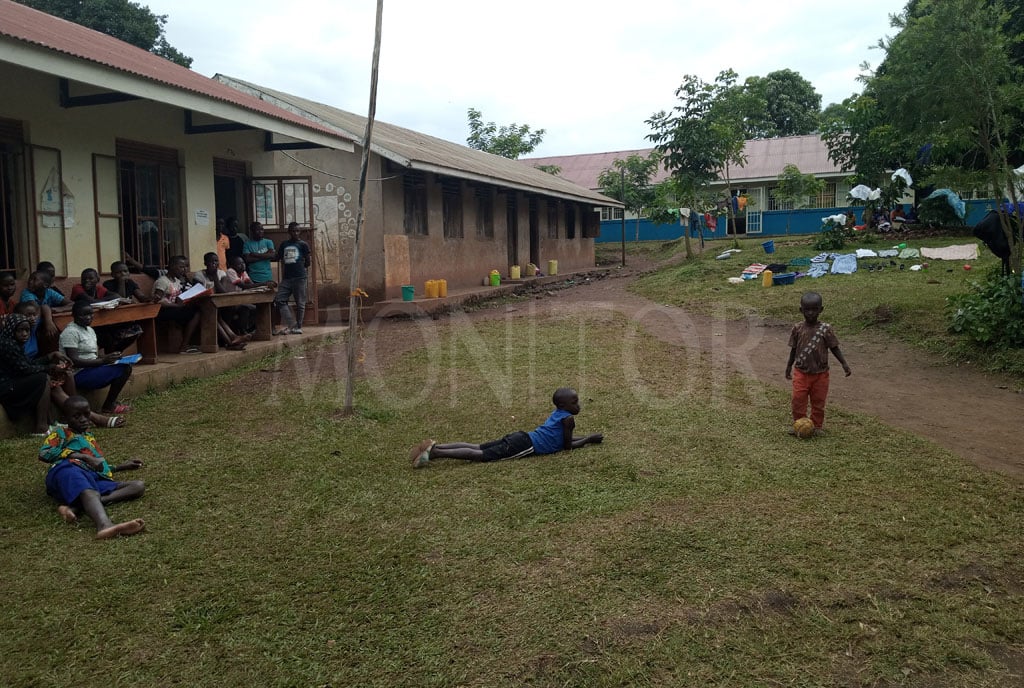What’s with overwhelming pupil numbers in schools

Some of the pupils seated outside a classroom block at Rwengobe Primary School in Kamwenge District on March 24, 2022. PHOTO | ALEX ASHABA
What you need to know:
- Introduction of UPE in 1997 contributed to gross enrolment in primary schools which increased from a total of 3.1 million in 1996 to 5.3 million in 1997, an increase of 73 per cent in one year.
- By 2003, gross enrolment in primary schools had reached 7.6 million. The national gross primary school enrolment ratio in 2003 was 127 per cent, indicating that children beyond standard primary-school age had rejoined the primary education cycle.
On Tuesday, two articles run on Page 27 titled: 1,700 pupils study in shifts at Zombo school and Classroom shortages hit Kamwenge schools.
Overwhelming enrolments in primary schools, especially government aided has been a concern over the years. This is attributed to the introduction of Universal Primary Education (UPE). UPE is an umbrella term for several policies targeted at improving primary school access and quality. In Uganda, UPE includes free primary education and greater investments in the education sector as a whole, as well as building more schools and hiring more teachers.
In 1997, as part of the UPE agenda, the government of Uganda formally abolished primary school tuition, Parents and Teachers Association and textbook fees for up to four children per family. This no-fee policy was rolled out across all primary school grades, rather than being introduced cohort-by-cohort. UPE was viewed as an important tool to bring children into the school system. For parents, the financial burden of enrolling their children in school was not insignificant as they were expected to finance around 60 per cent of the costs, and this had a direct and negative effect on enrolment rates, the pupil to teacher ratio, and primary completion rates.
Several countries implemented UPE in the 1990s and 2000s. Several policies have been implemented for the last 30 years and more in different ways. For example, Malawi abolished school fees for Grade One students with effect from 1991 and for primary students in 1994. In Kenya, UPE was rolled out for all categories of students in 2003 similar to Uganda’s implementation.
In 2020, the world was confronted with the unprecedented Covid-19 pandemic. Ugandan schools were re-opened after a nearly two-year shutdown as a result of the pandemic social control measures that led to closure of schools. However, the majority of students have returned. The government of Uganda launched a one-month back-to-school campaign to ensure all children return which could have also contributed to the overwhelming enrolment in primary schools.
Pupil to classroom ratio
Uganda Bureau of Statistics (UBoS) latest figures under the 2015 Statistical Abstract, two thirds of the country’s districts have big primary classes as opposed to the national average of 58 students. What does this mean for teachers?
Teachers face many obstacles as they attempt to teach overwhelming pupil numbers. The obstacles include instructional, management, and assessment and discipline problems. One of the problems faced by teachers in public schools is crowded classrooms. Overwhelming enrolment has resulted in frustration, learners becoming despondent and discouraged as well as negative attitude. Such classrooms have a direct impact on teaching and learning.
Overwhelming enrolment has not only affected learner performance but also put immense stress on teachers and impact on morale and enjoyment of their profession. Teachers face many challenges including discipline, lack of space in the classroom, inability of the teacher to assist weak learners, increased workload in terms of marking and instructional problems.
According to Lannoy and Hall, education scholars, learner to teacher ratio relates directly to the quality of schooling. The larger the class, the harder it is for the educator to know the circumstances of individual learners. There are policies that stipulate the learner to teacher ratio, however the policies are not being implemented and schools are admitting more learners into the classroom without thinking about the impact on teachers.
Teachers are required to provide the best learning experience for learners. In circumstances such as an overcrowded classroom, it is not achievable for learners to attain educational goals. When a class size is reduced, it allows effective teaching and learning. I believe if the problem of overwhelming enrolment is addressed, teachers will provide quality teaching and learning. Peter Mtika, an education scholar says, smaller classes give room to teacher-pupil interactions and provide individual attention to slow learners.
Studies from other countries have indicated that several teachers are stressed and frustrated due to overwhelming enrolments to the point where they are considering dropping the teaching profession.
Studies argue that teachers are registering negative experiences as a result of overwhelming enrolment and abandoning the teaching profession. It is imperative to note that handling large classes leads to teacher stress. These responses are consistent with most findings. Teachers can also experience emotional and psychological issues due to increased workload. Overwhelming enrolments have a large number of learners and therefore teachers’ workload would increase in terms of marking and assessment and this could also become stressful for teachers. This affects productivity on quality education outcomes.
What teachers can cope
Positive behavioural support is one of the ways to manage tasks in large classrooms. McDougall (2004) claims that teachers should use positive verbal reinforcement as opposed to shouting and screaming.
Tasks should also be modified to incorporate students interests. Benbow et al (2007) also contends that some of the ways to overcome the problems associated with overwhelming enrolment is through team teaching and peer teaching. This would be a effective method in managing overcrowded classrooms as it allows more than one person to teach the lesson as opposed to just one teacher managing and teaching which is stressful as research has indicated.
Teacher support groups
Such groups usually comprise three or more teachers are support systems that teachers of the same school create. Teachers use them to work collaboratively and search for solutions to problems that arise in the development of the teaching profession. These groups help teachers to share their respective challenges and thereafter get back to their classrooms to implement the solutions as guided by their colleagues.
Interactive learning
This style is a more hands-on, real-world process of relaying information in classrooms. Passive learning relies on listening to teacher’s lecture or rote memorisation of information, figures, or equations.
With interactive learning, students are invited to participate in the conversation, through technology (for instance, online reading and math programmes) or through role-playing group exercises in class. The benefits of interactive learning activities cannot be overstated and several case studies have already revealed the vast advantages it harbours. It involves learning as part of a group or family helping scholars not only comprehend the concepts discussed, but also brushes up on social and emotional skills. This kind of learning establishes a learning environment that allows both the teacher and pupils to engage in participatory illustrations, debates, role-plays, games and skits.
Each activity used in interactive learning makes it easier to practice the skills acquired especially when real-life situations are thrown into the mix during role-plays and skits.
Collaborative learning
“Collaborative learning” is an umbrella term for a variety of educational approaches involving joint intellectual effort by students, or students and teachers together. Usually, students are working in groups of two or more, mutually searching for understanding, solutions, or creating a product. Learning activities vary widely, but most centre on students’ exploration or application of the course material, not simply the teacher’s presentation or explication of it. Collaborative learning represents a significant shift away from the typical teacher-centred in classrooms. In collaborative classrooms, the teaching or listening and note-taking process may not disappear, but it lives alongside other processes that are based in students’ discussion and active work with the course material.
Teachers who use collaborative learning approaches tend to think of themselves less as expert transmitters of knowledge to students, and more as expert designers of intellectual experiences for students-as coaches.
Establish guidelines
A large classroom can be noisy, therefore it is important to establish guidelines early in the year to help control the noise levels. Routines are important in a large class and, students should be taught how to get into routine and establish what they are supposed to do early in the year.
Pupil learning outcomes
Education indicators suggest that expanded elementary school enrolment may have come at the expense of educational quality. In Uganda’s schools today, students overcrowd classrooms, overwhelming the country’s understaffed teacher corps.
According to Unesco data, there are about 43 pupils per teacher at the elementary level, above the world average of 23, and even above the sub-Saharan African average of 38. The increased pupil enrolment affects quality of learning as classes due to the overcrowding contribution to noisemaking, poor class control, teachers overwhelmed by work and sharing of textbooks among the pupils.
Poor quality of primary education manifests itself in various ways including low learning outcomes (particularly numeracy and literacy), low efficiency, the role of high teachers’ absenteeism and inadequate school management supervision due to overwhelming enrolment levels. In 2014, the National Planning Authority report established that inadequate school facilities, the pupil classroom ratio for government aided schools was 69 to one (since total classroom stock was 103,168 while total enrolment was 7,124,124. The target is 45 pupils to one teacher.
Low learning achievements
The percentage of Primary Six pupils rated proficient in numeracy and literacy at 40.2per cent and 41.4per cent in 2013 (education management information system 2014) respectively. This implies that more than half of the pupils enrolled in Primary Six can neither count nor read and write simple sentences. In 2014, total enrolment in government-aided schools stood at about 7.1 million, teachers on government payroll at 131,000. Thus, pupil teacher ratio of 54 to one. The target pupil to teacher ratio is 45 to one, according to education and sports sector annual performance report, giving an estimated qualified teacher gap of 27,003 in government schools alone. Such ratios lead to higher dropout rates.
The enrollment challenges facing primary schools include; sharing of learning materials, queuing in order to use some facilities such as toilets, increased indiscipline among pupils and overcrowding in classrooms. Note that increased enrolment affects quality of learning as classes where overcrowding contributes to noise making and poor class control, hindering teachers from marking the given exercises, and that learners have to share textbooks. This implies that the quality of learning is compromised.
Possible way out
Therefore, policy makers as well as government authorities need to develop policies to govern enrolment ratios on both human and material resources to ensure that the quality of learning in public primary schools is not compromised by increased enrolments. Also, employment of more teachers and building more classrooms would be the best strategies to address the enrolment challenges facing primary schools.
Also, management of the school should have regular meetings that promote professional development and team building. They also need to look at how to assist teachers with discipline and curriculum-related matters so that more time can be given to teaching.
School policies should be used as reference and where necessary the schools should invite the relevant stakeholders from the ministry of Education for support. In these forums, policy implementation should be addressed in relation to the enrolment of learners in each classroom. The management of the school should have regular meetings that promote professional development and team building. They also need to look at ways of assisting teachers with discipline and curriculum related matters so that more time can be given to teaching. Also, integrating service -learning in the training of learners. This would give them an opportunity for community work that would helps them understand better the theories learnt in class as they experience real-world situations.
Increasing the participation of parents and communities to support school construction is crucial because it can increase their voice on accountability through social audits.
The writer is a researcher and PhD student, public policy and governance, Kyambogo University.




